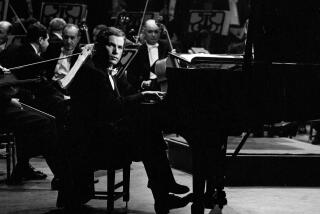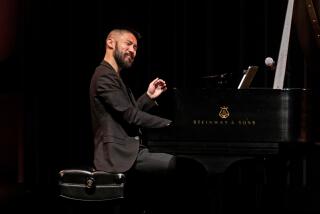Mediocrity Shines in Love for Helfgott’s ‘Rach 3’
- Share via
The movie “Shine” has created a phenomenon that suggests a new low in standards for classical music--something to which I am no doubt contributing by writing about the film for the second time in two weeks.
Lest anyone has forgotten, “Shine” is an art-cinema house release that tells the real-life story of pianist David Helfgott, the severe mental breakdown he suffered as a consequence of his struggles to free himself of his domineering father and to learn the monumentally difficult Rachmaninoff Piano Concerto No. 3 (the “Rach 3” in the parlance of the movie and of pianists) and his remarkable reentry into life.
Now some facts.
Every evening at about 7, when “Shine’s” performance lets out at a Baltimore theater, dozens of moviegoers troop over to a nearby music store and--guess what?--they all want the “Rach 3.” The store cannot keep enough compact discs of the piece in stock to satisfy the demand and has on reorder multiple copies of several different performances--25 of the Martha Argerich recording on Philips alone.
And the store does not yet have in stock the performance everyone really wants--Helfgott’s own recording on BMG Classics, which the company cannot seem to manufacture quickly enough. Although the BMG recording has so far appeared only at huge chains such as Tower Records, it has become the fastest-selling classical CD in the United States. Last week sales of Helfgott’s Rachmaninoff disc surpassed those of the hugely popular crossover album “Appalachian Waltz,” which was recorded by cellist Yo-Yo Ma and several bluegrass artists. We thus have the peculiar case of a straight classical release by an obscure pianist, unknown outside his native Australia before “Shine’s” Christmas release, outpacing a crossover album by one of the greatest and most beloved classical musicians of the last half-century.
Things are about to get stranger still. Music fans will get a chance to watch the Helfgott phenomenon up close during a 26-city U.S. tour this spring. When tickets became available in Los Angeles for the March 25 concert at the Dorothy Chandler Pavilion, they sold out in less than three hours. (A March 27 date was added.)
Expect the same thing to happen everywhere.
This is unheard of. The last time I can remember a large hall selling out in so little time for a classical musician was more than 30 years ago, when Vladimir Horowitz--the century’s most celebrated pianist--announced his return, after a 12-year absence, to the concert stage. And that was at New York’s Carnegie Hall, the Holy Temple in classical music’s Mecca.
And as “Shine,” now a limited release, begins to receive wider distribution, we can expect Helfgott’s to become the best-selling recording of the Rach 3 in history--beating all three of Horowitz’s, all four of Vladimir Ashkenazy’s, as well as those of Argerich, Van Cliburn and Evgeny Kissin, and possibly all of them put together.
All of this marks a significant new step in what has been called the dumbing of America.
It means that even among what are presumably the United States’ most sophisticated people--i.e., those who go to art-cinema houses to see movies such as “Shine” or Mike Leigh’s “Secrets and Lies”--it’s video, whether on TV or in the movies, that sells a musician to the public. This is a celebrity that has nothing to do with how well a musician actually plays. As a critic, I cannot say that Itzhak Perlman is a better violinist than Elmar Oliveira or that Yo-Yo Ma is a better cellist than Stephen Kates. What I do know is that both Perlman and Ma have had repeated opportunities, such as appearances on TV’s “Sesame Street,” to ingratiate themselves with the public. We want to hear Helfgott because we have fallen in love with him--or, at least, fallen in love with him as he is brilliantly portrayed by actor Geoffrey Rush in “Shine.”
*
What makes the Helfgott case a new departure, however, is that heretofore almost all classical music celebrities--down to today’s three tenors--have had the musical goods; Helfgott doesn’t. The current catalog lists 39 recordings of the Rachmaninoff Third Concerto. Since I own 36 of them (and have heard the other three), I feel safe in saying that they’re all better than Helfgott’s, which is technically labored, interpretively limited and--outside the context of the movie--emotionally unaffecting. However inadvertently, “Shine”--which took director Scott Hicks 10 years to make on a shoestring budget--has turned into what may be the most remarkable case of marketing in the history of classical music.
And I had better make these confessions: I loved “Shine” (which I’ve seen three times), I bought Helfgott’s Rach 3 album as soon as it came out, and I listened to it with pleasure for two or three days, until the film’s emotionally powerful wake finally began to dissipate.
In writing his Third Concerto to perform during his first American tour in 1909, Rachmaninoff produced what remains the most difficult concerto in the standard repertory--one that calls upon the pianist to play more notes per minute than any other. Stravinsky once referred to the towering composer as a “6-foot-6-inch scowl,” but the saturnine Rachmaninoff may have been enjoying a practical joke when he wrote the Third Concerto. He dedicated it to his friend, Josef Hoffman, then considered the world’s greatest pianist. But Hoffman never played it--he couldn’t, and neither could anyone else.
For almost 20 years--not until the emergence of Horowitz in the late 1920s--only Rachmaninoff played the Rach 3. Even today, when the Rach 3 has become the concerto most often chosen by young pianists in competitions, there are only a handful who play it really well.
In “Shine,” the warning Helfgott receives from Cyril Smith, his teacher, is apt: “Make no mistake about it, David; it’s dangerous--it’s playing without a safety net; people can get hurt!”
Let’s be clear about what kind of entertainment we are buying, either when purchasing Helfgott’s record or a ticket to one of his concerts. We are paying to hear a musician who for 12 years was a patient at state-run mental hospitals and whose childlike behavior even now--to judge from the somewhat sanitized portrait in “Shine”--betokens his suffering from serious mental and emotional disabilities.
Bluntly put, we are going to the circus to see what used to be called the “freak show.”
There’s always been an element of the circus in the marketing of classical musicians. It was P.T. Barnum, after all, who first brought the “Swedish nightingale,” soprano Jenny Lind, to America. And classical music’s past and current preoccupation with prodigies--such as violinist Sarah Chang, who made a best-selling CD of the Tchaikovsky Concerto as a 10-year-old, and, more recently, the 9-year-old cellist Ha Nang, who has already made her first recording for a major label--has produced a freak show of sorts. The original meaning of the word “prodigy” was that of “a freak of nature”--an extraordinary portent, usually signifying evil, such as the sudden appearance of a comet or the birth of a two-headed baby.
Seen this way, the Helfgott phenomenon is merely the appearance on the classical musical scene of the latest prodigy--albeit one of a quite different kind than his Wunderkind predecessors.
The appearance of this particular prodigy, however, is a portent that should make those of us who care about classical music uneasy about its future.
More to Read
The biggest entertainment stories
Get our big stories about Hollywood, film, television, music, arts, culture and more right in your inbox as soon as they publish.
You may occasionally receive promotional content from the Los Angeles Times.










